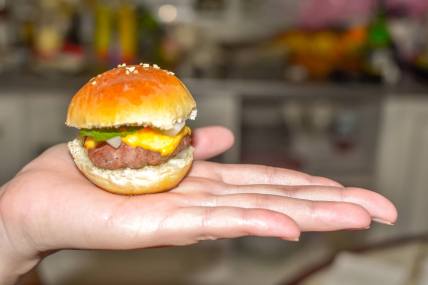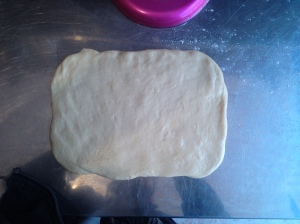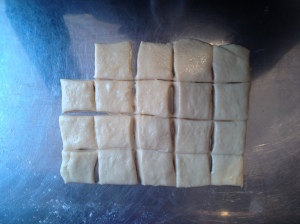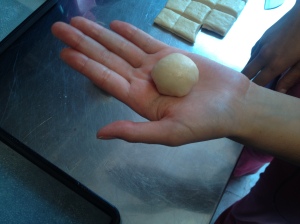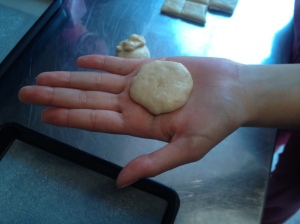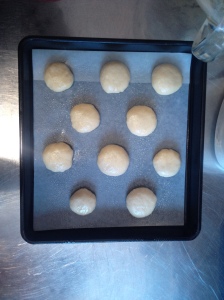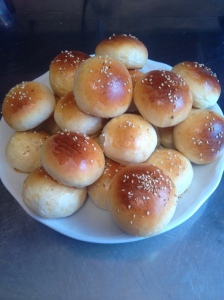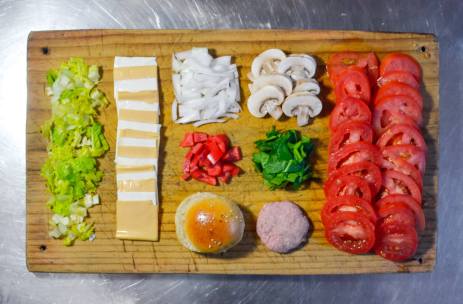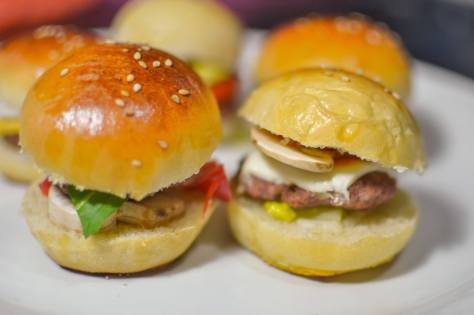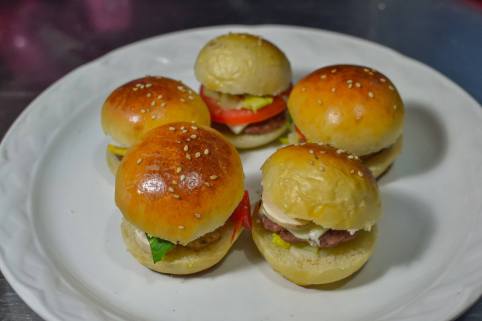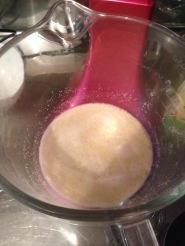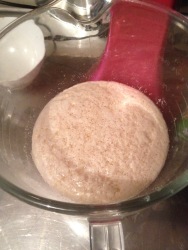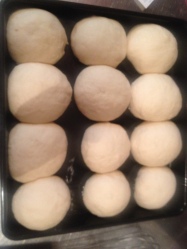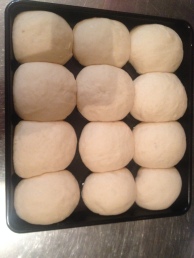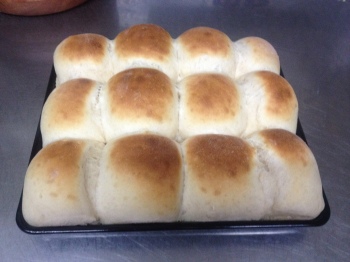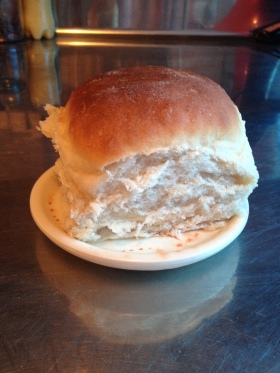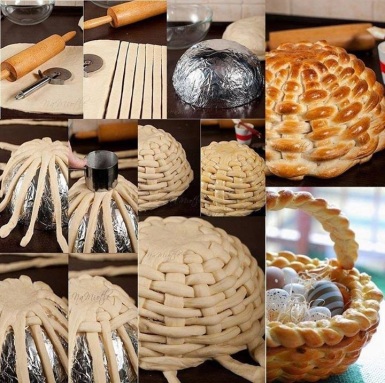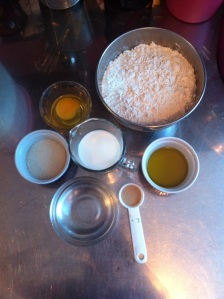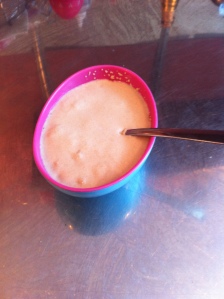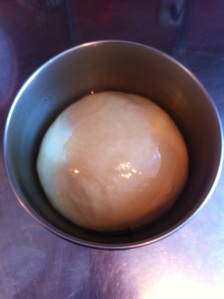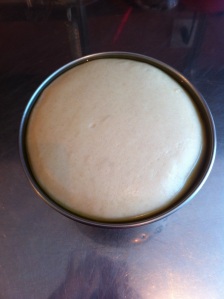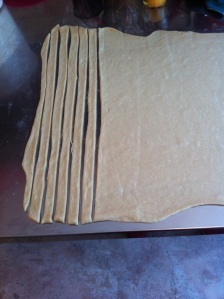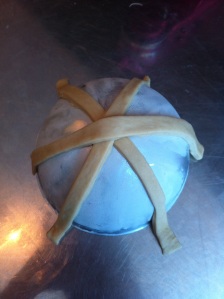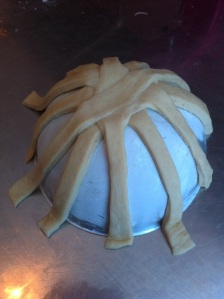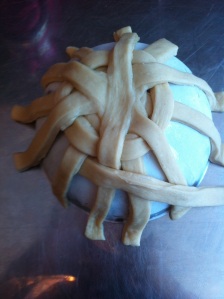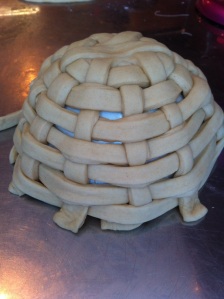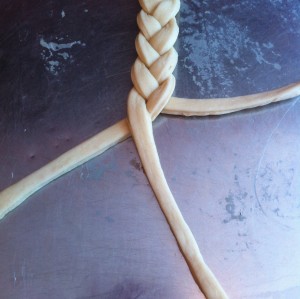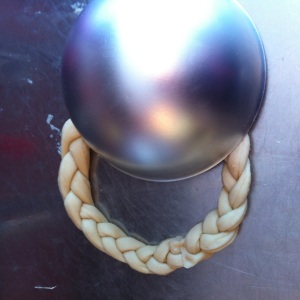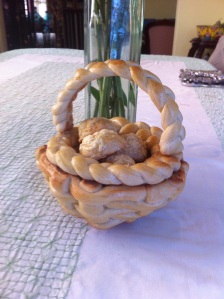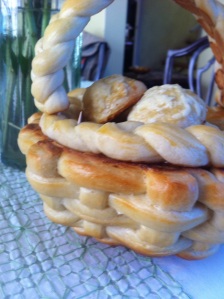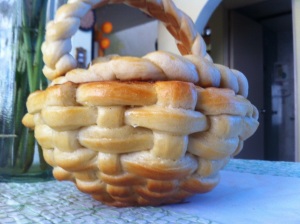Click for the English Version
Bueno, historia de ésta receta es simple: la vi en Tumblr y decidí adaptarla por que se me antojó. Aparte de eso, después de un par de días ganó la guerra de Mini Hmburguesas VS Soufflé de Red Velvet que posteé en mi Facebook.
Si hablas inglés, te dejo un vídeo para que te des ideas de cómo darle un giro interesante a tus hamburguesas; y otro video por si quieres aprender a hacer pepinillos. Si de verdad te gustan las hamburguesas exóticas, te dejo el link de un show acerca de hamburguesas realmente interesantes. Es una lástima que ya no lo produzcan, pero creo que vas a disfrutar los episodios que ya existen.
Lo más complicado de ésta receta es el pan. La masa de hamburguesas es una masa tipo Brioche, que es, en mi opinión, la más complicada. Es muy completa, y es bastante pegajosa. Recomiendo que no la hagas si no tienes experiencia previa de panadería. Para ésto tengo dos alternativas:
-
Usar los pequeños panecitos rellenos de queso que venden el el súper, cortándolos por la mitad.
-
Ir a una panadería local y pedir que te hagan los panes.
Ingredientes:
Pan:
- 1 taza de harina (puedes llegar a usar hasta 2, dependiendo del clima)
- 1/3 de taza de leche en polvo
- 1 huevo
- 45 ml de leche
- 45 ml agua
- 1 cucharadita de mantequilla
- 2 cucharaditas de aceite de olivo
- 1 cucharadita de sal
- 1 cucharada de azúcar
- 1 cucharada de levadura
- Ajonjolí, al gusto
- 1 yema (para barnizar)
Carne
- 1/4 kg de carne molida de res
- 1/4 kg de carne molida de cerdo
- Cebolla picada finamente, al gusto
- Albahaca, cebollín, perejil, cilantro o cualquier hierba de tu preferencia, al gusto
- Sal al gusto
- Pimienta al gusto
- Cualquier otro sazonador en polvo. Puedes usar ajo en polvo, cebolla en polvo, alguna pimienta interesante (blanca, gorda, rosa)
Puedes hacer lo que yo hice (tomar el camino de los flojos) y comprar carne de hamburguesas ya preparada.
Te recomiendo que si haces ésto, compres carne de calidad, como la que venden en las carnicerías, no en el super. Las hamburguesas congeladas son raras, y se van a deshacer en cuanto intentes darles forma.
Si, por el contrario, eres una persona con muchos ánimos de vivir, busca carne con un buen contenido de grasa. La grasa le va a dar sabor a tus hamburguesas.
Guarniciones:
- Pepinillos
- Salsa de tomate
- Mostaza
- Mayonesa
- Cebolla
- Queso amarillo
- Jitomate
- Lechuga
Obviamente puedes usar lo que se te de la gana.
Instrucciones:
Pan:
1.- Calentar el agua, la leche y la mantequilla.
No calientes ésta mezcla más allá de los 60°C, eso mataría la levadura.
2.- Agrega el azúcar y mezcla perfectamente.
3.- Agrega la levadura, mezcla y deja descansar durante 5 minutos.
4.- Mezcla la leche en polvo, harina y sal.
5.- Agrega el huevo, la mezcla de leche e integra bien. Puedes hacerlo a mano o en batidora, con el gancho para pan.
6.- Vierte el aceite de olivo, integra bien y amasa por 10 minutos, o hasta que la mezcla esté lisa, y se despegue de tus manos.
Recuerda que ésta masa es bastante pegajosa, así que tendrás que juzgar la masa por qué tan lisa esté.
7.- Recubre un recipiente hondo con un poco de aceite y coloca tu masa. Agrega aceite para cubrirla toda y deja en un lugar cálido, sin corrientes de aire, durante dos horas o hasta que el tamaño de la masa se haya duplicado.
8.- Amasa un poco la masa (válgame la redundancia) para desinflarla bien. Divide en porciones pequeñas y haz bolitas (más o menos del tamaño de una pelota de golf). Aplasta las bolitas y colócalas en una bandeja de horno con papel encerado, harina o cualquier método para que no se peguen.
9.- Deja reposar media hora o hasta que hayan duplicado su tamaño (otra vez).
10.- Barniza con la yema y espolvorea ajonjolí al gusto.
Ten mucho cuidado cuando barnices los panes. En éste momento son muy frágiles, y si los desinflas, a la hora de hornearse van a quedar… pues… desinflados.
11.- Hornea a 180°C o hasta que los panes estén dorados de la parte de arriba.
12.- Deja enfriar y corta a la mitad, horizontalmente. La parte de arriba debe ser un poco más grande.
Si eres un flojo como yo y te rehusas a pesar tus panes para que todos queden exactamente del mismo tamaño, puedes hacer lo que hice yo: aplanar la masa, formar un rectángulo y cortarlo en cuadrícula. Luego formas una bolita con cada cuadrito ¡y listo!… No quedan todos del mismo tamaño pero… más o menos.
Como éstos panes son muy pequeños, es ideal que no varíen tanto los tamaños. Si no puedes hacer todas tus bolitas iguales, ni aunque tu vida dependiera de ello (como yo) por lo menos sepáralas en bolitas más grandes y bolitas más chicas, y hornéalas en dos tandas (o tres, o cuatro).
Carne:
Si vas a hacer la carne desde cero, sólo mezcla todos tus ingredientes,excepto cualquier tipo de sal, ésa va justo antes de cocinar la hamburguesa.
1.- Mezcla los ingredientes en un bowl.
2.- Mójate un poco las manos y haz bolitas de carne, luego aplástalas para darles la forma. Ten el cuenta el tamaño de tu pan. Dales el tamaño que quieres desde el principio. Sazónalas con sal justo antes de ponerlas en la sartén.
3.- Calienta aceite en una sartén a fuego medio, y cuando empiece a humear ligeramente, coloca tus hamburguesas. No las aplastes. Para que no que encojan, pícalas con la punta de un cuchillo, varias veces, y hasta tocar la sartén.
4.- Cuando estén listas, retíralas de la sartén y déjalas descansar un rato en una servilleta o toalla de papel, para remover el exceso de aceite.
Si quieres ponerles queso, en cuanto la parte de abajo esté lista, dale la vuelta a la carne y coloca el queso arriba, para que se derrita.
Ensamble:
Realmente no sé si es necesario indicarles cómo ensamblar una hamburguesa, porque pues…no hay reglas.
Si te gusta el pan caliente, pon ambas caras con el corte hacia abajo en la sartén un par de minutos antes de ensamblar tu hamburguesa.
Si quieres mi opinión al respecto (y no viste ninguno de los videos que cité al inicio) es una buena idea variar con los ingredientes de las hamburguesas.
* Es decir, usar varios tipos de carne (pollo, pescado, cerdo, venado, caballo, pavo real, cisne, conejo, camarón, langosta o cualquier carne que sea legal en tu país),
* panes fuera de lo común (como chapata, bagel, focaccia, bolillo, telera, sour dough o cualquier locura con la que tu panadería local haya salido ésta semana),
* varios tipos de salsas (BBQ, mostaza de dijón, aderezo ranch, vinagretas, mermeladas, mantequilla de cacahuate, pesto, la mejor salsa de tu abuelita, o lo que sea que encuentres en tu refrigerador),
* quesos interesantes (mozzarella, queso crema, mascarpone, parmesano, queso de rancho, quesorpresa, quesuave, cheez whiz, chihuahua o lo que haya en tu quesería más cercana),
* y al último, guarniciones originales (encurtidos de verduras, huevo estrellado, papas a la francesa, cebolla caramelizada, una sandía pequeña {de 8 kilos}, o cualquiera de esas cosas hechas de verduras que venden en los supermercados caros).
English Version
The story for this recipe is very simple: I saw it on Tumblr and I liked it. Apart from that, this one won the Mini Hamburgers VS Red Velvet Soufflé war when I posted about it on Facebook some days ago.
So, here’s a vídeo that’ll get you thinking on how to give your burgers a twist; and another one if you want to make your own pickles. Now, if you Really like burgers, here’s the link to Burger lab, a show by Tasted which features the making of some amazing burgers. The fact that it’s no longer produced is a real shame, but I know you’ll enjoy the episodes in existence.
The most complicated thing in this recipe is the bread. The dough is called Brioche, and it’s, in my opinion, the most complicated dough of them all. It’s very rich and, because of that, very sticky. If you have no previouse expirience in bread-making, I recommend you buy some other kind of buns that fit the purpose.
Ingredients:
Buns:
- 1 Cup of flour (depending on the weather, you can use up to 2 cups)
- 1/3 cup powdered milk
- 1 egg
- 45 ml milk
- 45 ml water
- 1 tsp butter
- 2 tsp olive oil
- 1 tsp salt
- 1 Tbsp sugar
- 1 Tbsp yeast
- Sesame seeds, to taste
- 1 yolk to brush the tops of the bread
Patties:
- 1/4 kg ground beef
- 1/4 kg ground pork
- Finely chopped onion, to taste
- Finely choped herb of your preference
- Salt to taste
- Pepper, to taste
I reccomend doing this from scratch. Frozen patties are not very high quality, and they may not re-shape as well.
Be sure to get good quality meat, not lean, with a high fat content. Fat means more flavor.
Garnishing:
- Pickles
- Ketchup
- Mustard
- Mayonaise
- Onions
- Cheese
- Tomatoes
- Lettuce
You can obviously use whatever floats your boat.
Instruccions:
Buns:
1.- Warm the milk up to 60°C, add the butter and the sugar
Don’t warm the milk up any higher than 60°C, it will kill the yeast.
2.- Add the sugar and mix well.
3.- Add the yeast and let the mixture rest for 5 minutes.
4.- In another bowl, mix the powdered milk, salt and flour.
5.- Add the egg, the yeast mixture and mix. You can do this by hand or in a stand mixer.
6.- Drizzle the olive oil and knead the dough for about ten minutes, or until it’s smooth and unsticks itself from your hands.
Remember, this dough is very sticky, so you’ll have to judge if it’s done from how smooth it is..
7.- Drizzle a bit more olive oil in a bowl and place your dough there. Brush the though with oil to prevent it from forming a crust. Leave this on a warm place with no air currents for two hours or until doubled in size.
8.- After it has risen, knead the dough well to take the air out. Divide the dough in small portions and make balls the size of a golf ball. Line them separately on a baking sheet with flour, non-stick spray, parchment paper or whatever no-sticking method you want.
9.- Let the dough rest again until it’s doubled in size (again).
10.- Brush the top of the bread with the egg yolk and sprinkle on some sesame seeds.
Be careful not to poke the bread. It’s a bit fragile in this state. If it deflates it will turn out… Well… Flat.
11.- Bake at 180°C for 10 minutes or until golden brown on top.
12.- Let cool completely and slice horizontally.
If you’re as lazy as me, and won’t weigh your dough pieces so all of them are the same size, you can do as I did: flatten your dough in a rectangle form and then cut squares. I’m not sating my squares were the same size, but that’s the easiest way to separate your dough.
Becausde this buns are so tiny, it’s best not to vary too much in sizes when you bake. You can do as I did and separate the tiny ones from the teeny-tiny ones, and bake in two battches. Or three. Or four.
Patties:
1.- Mix all the ingredients but salt, in a bowl.
2.- Wet your hands before forming each patty, form a little ball and flatten it out. Keep the size of the buns in mind. Season the meat just before it goes on the pan.
3.- Heat enough oil in a pan, and when it starts smoking lightly, add your patties. poke them with a knife all the way down to the pan to keep them from shrinking. Flip and add cheese if you want it to melt on top.
4.- When done, let rest for a while on a paper towel to get rid of the excess oil.
Ensamble:
I’m not sure if it’s really necessary to teach you how to put together a hamburger… so…
If you like to toast your bun, put it cut face down on the pan a couple minutes before you’re ready to eat your burger.
If you want my opinion on the subject (and did not bother to check out any of the videos I cited above), I think it’s a good idea to vary with the ingredients on a burger.
* I mean, use various types of meat (Beef, pork, chicken, fish, shrimp, goose, rabit, horse, swan, shrimp, lobster or whatever’s legal in your country),
* maybe some different types of bread (chiabatta, baguette, white bread, whole wheat, sourdough),
* various kinds of sauces (BBQ, ranch dressing, dijon mustard, peanut butter, jam, your grandma’s famous pasta sauce),
* interesting cheeses (roquefort, mascarpone, emmental, parmesan),
* and lastly, some other add-ons (pickled vegetables, french fries, a sunny-side egg, a watermelon [a tiny one, about 10 pounds], or any of that fancy vegetable salads they sell on glass bottles at the supermarket).

